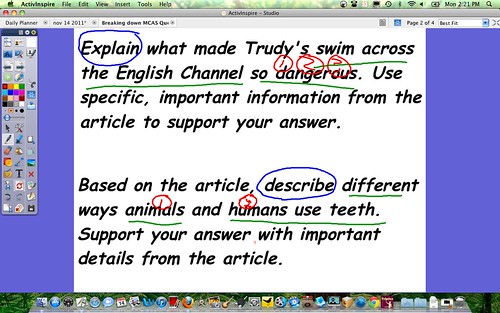One thing that I have learned in teaching various strategies around open response to my sixth graders over the years is that many have a real difficulty understanding the question itself (this seems more for math than reading). They get hobbled by the vocabulary, or the style in which the question has been written, or they get confused by multiple-part questions. This year, thanks to an interesting workshop that I attended last month around open response work, I am trying to do more work around how to read a question.
So, yesterday, we began some work by reading … only open response questions. We had no ideas what the reading passage was that the question asked about, nor did we care all that much what the answer might be. We were only focused on questions, and I now have a long list of open response questions from various state tests as a resource.
The strategy is three-fold:
- Circle the action word that you are being asked to do;
- Underline the main essential points of the question;
- Number any parts of the question or topics that seem important.
We went through three of four of these questions together on our whiteboard (see image) with students coming up and marking up the sentence while talking through what they were doing, and then they worked on a few questions at their seats, which we then shared out. Our next step is for them to learn how to use a modified two-column chart for organizing their ideas before they start to write. (This is where the numbering of items will come in handy because we can deal with main ideas and supporting details).
It seems a bit odd to be using so much class time for this kind of isolated question dissection, and yet, I am attempting to give them the tools so that they can be the most successful in my assigned open response questions (which is what we mostly do now in our reading units) and on our state’s testing system in the spring. Organization and understanding of what is being asked of them in a question seem be roadblocks for many, and I want them to be confident as they share their thinking.
Peace (in the question),
Kevin

I spend a lot of time with my students analyzing writing prompts in this way, too. I use a method from Ralph Fletcher and JoAnn Portalupi in Teaching the Qualities of Writing. RUPR asks students to Read, Underline, Plan and Reread before writing their essay. Past students have shared it is time well-spent. Now I can add these steps as another tool, too. Then we can get back to real reading and writing.
It’s time well spent. It takes my sixth graders almost all year to internalize this type of dissection – but they never forget it!
Great use of time. You can answer a question if you don’t understand what it’s asking. Thanks for sharing your.thoughts.